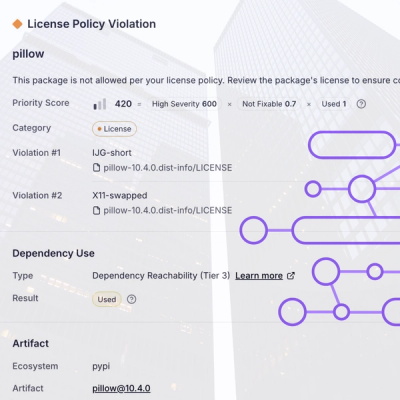
Research
/Security News
Critical Vulnerability in NestJS Devtools: Localhost RCE via Sandbox Escape
A flawed sandbox in @nestjs/devtools-integration lets attackers run code on your machine via CSRF, leading to full Remote Code Execution (RCE).
.. image:: https://travis-ci.org/GreatFruitOmsk/tailhead.svg?branch=master
Python tail is a simple implementation of GNU tail and head.
It provides 3 main functions that can be performed on any file-like object that supports seek() and tell().
tail - read lines from the end of a filehead - read lines from the top of a filefollow - read lines as a file growsIt also comes with pytail, a command line version offering the same functionality as GNU tail. This can be particularly useful on Windows systems that have no tail equivalent.
tailhead on GitHub <tailhead>_tailhead on Pypi <http://pypi.python.org/pypi/tailhead>_Install with pip or easy_install.
::
pip install tailhead
::
import tailhead f = open('test.txt', 'w') for i in range(11): f.write('Line %d\n' % (i + 1)) f.close()
::
# Get the last 3 lines of the file
tailhead.tail(open('test.txt'), 3)
# ['Line 9', 'Line 10', 'Line 11']
::
# Get the first 3 lines of the file
tailhead.head(open('test.txt'), 3)
# ['Line 1', 'Line 2', 'Line 3']
::
# Follow the file as it grows
for line in tailhead.follow_path('test.txt'):
if line is not None:
print(line)
else:
# sleep
Tailer currently only has doctests.
Run tests with nose::
nosetests --with-doctest tailhead
Run tests with doctest::
python -m doctest -v tailhead/__init__.py
FAQs
tailhead is a simple implementation of GNU tail and head.
We found that tailhead demonstrated a healthy version release cadence and project activity because the last version was released less than a year ago. It has 1 open source maintainer collaborating on the project.
Did you know?

Socket for GitHub automatically highlights issues in each pull request and monitors the health of all your open source dependencies. Discover the contents of your packages and block harmful activity before you install or update your dependencies.

Research
/Security News
A flawed sandbox in @nestjs/devtools-integration lets attackers run code on your machine via CSRF, leading to full Remote Code Execution (RCE).

Product
Customize license detection with Socket’s new license overlays: gain control, reduce noise, and handle edge cases with precision.

Product
Socket now supports Rust and Cargo, offering package search for all users and experimental SBOM generation for enterprise projects.